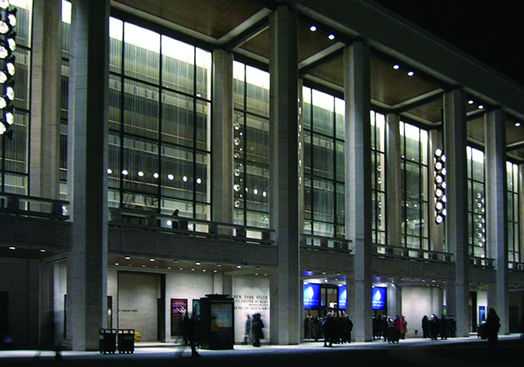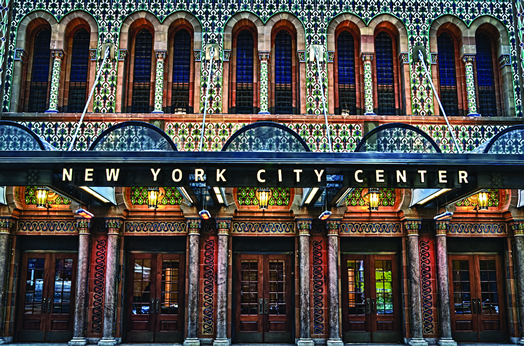Allegro
The NYC Ballet Celebrates 50 Years at Lincoln Center
In recognition of this milestone, we asked NYC Ballet orchestra members to send their favorite memories...
Volume 114, No. 7July, 2014

The David H. Koch Theater (formerly the New York State Theater), where the New York City Ballet moved in 1964.
I joined the New York City Ballet Orchestra as timpanist/percussionist in October 1950. I played there until February 2014 and was also orchestra manager from 1972 until 2012. We performed at New York City Center until 1964, when the company moved to its new home at the New York State Theater (now called the David H. Koch Theater) at Lincoln Center. We were thrilled with our new pit! (Mr. Balanchine actually had it enlarged before we got there).
I must admit though, the one thing missing at the Koch theater, was our contact with Mr B. and the dancers. At intermissions at City Center, some of us would leave our basement “lounge” and congregate at the water cooler off stage.
I especially remember meeting many times the great ballerina Maria Tallchief at the cooler in her “Firebird” costume We had a little exchange that went like this each time:
ME: “Are you dancing?”
MARIA: “Are you asking?”
ME: “I’m asking!”
MARIA: “I’m dancing!”
Then she would give me a high-five.
These kinds of encounters really brought the company together. We would plan parties at the theater for the musicians and dancers. Several of us in the orchestra would form a combo and play music for dancing. I still have pictures of those parties. But being at the new theater certainly had its advantages. The orchestra finally had a decent place to be during intermissions. We actually had lockers, a lounge and places to sit.
Many of the players who auditioned and joined the orchestra when I was manager still remind me of what I would say to them at the time: “This is the best job in the city of New York!”
Playing the music that Mr. B and Jerry Robbins chose for their ballets was like playing a symphonic concert at every performance. And Robert Irving, the music director and conductor from 1958 to 1989, was greatly admired by both the orchestra and the dancers; he cared very much for his orchestra.
– Arnold Goldberg
I grew up just outside the city with parents determined to create cultural sophisticates of their children. My father and I had a Sunday afternoon subscription to the NYC Opera and my mother and I had one to the NYC Ballet, both newly arrived at the New York State Theater at Lincoln Center. I always enjoyed watching the opera, but I really loved listening to the ballet. My mother loved “Swan Lake” and “Coppelia” – I was bored by them, but loved “Agon” and “The Cage.” It was my first encounter with “modern” music and I was amazed. The harpist in the orchestra, Cynthia Otis (my predecessor), was a former student of my teacher and we’d go to the pit rail before the show to say hello every time. Even as a seven-year-old I thought, “That’s what I want to do!” Soon after I graduated from college, Cynthia called me to say she needed a sub for the first three weeks of the ballet season that year. Was I interested? I would need to learn and play “Swan Lake,” “Raymonda” (with the big harp variation), “Tombeau de Couperin,” Webern pieces, and Stravinsky’s “Agon,” “Orpheus,” and “Symphony in Three Movements.” All in the first week. I said yes. That was 35 years ago, and I am still there, these last 15 years as principal harp. In the early years, it wasn’t unusual to run into Mr. Balanchine on the way out after a show. He would always stop to compliment whatever solo or cadenza I had played that night. Now, that was a boss! As Arnie Goldberg always said, it was the best job in town. Still is.
– Sara Cutler

New York City Center, where the New York City Ballet resided from 1948 to 1964.
Lincoln Center has in some sense defined my life. When I was a pre-teen, my grandmother had front-row subscription tickets to the ballet. She liked the “good” view of the dancers. (Hey, she was old, but she wasn’t dead!) She often took me, and I spent about 80 percent of my time there watching the orchestra and the conductor – and ignoring the dance. I saw this old guy I recognized from the cover of my “Music Minus One” album. His name was David Walter. From afar he looked stern, foreboding and grave. Little did I know that he would prove to be none of the above, and play such a big part in my life.
As things progressed, a few years later I found myself back at Lincoln Center, more specifically as a music student at Juilliard. As good luck would have it, David Walter became my teacher. During lessons he smiled a lot, imparted tons of wisdom about music, and told me all about playing with Toscanini, and Casals, and working with Balanchine. He didn’t have the kindest words about the conductorial staff at the ballet. Perhaps he viewed playing there as a step down in his career, coming, as he did, from the NBC symphony. If he felt that way, I’m sorry. I know that his favorite dancer of all time was Merrill Ashley. Even when he was in his 70s and 80s I observed him getting googly-eyed when in the same room with her. Hey, what is it with these old folks and ballet dancers? He was a totally brilliant man, who before he went into music, had gotten a degree in math at City College.
After I graduated from Juilliard in 1985, David Walter needed a sub at the ballet for a week or so. He recommended me. Marin Alsop, who was then a regular sub of the orchestra, called me for a few gigs, (I’ll always be grateful to her for helping get my career started.) Subsequently, Marin’s father, Lamar, then the concertmaster, made sure that I auditioned when there next was a bass opening a year or two later. Well, wouldn’t you know, the ballet took me, even after the Met and the Philharmonic didn’t. (I swear, I don’t hold a grudge…I think!)
When I started playing with the ballet, I figured that since I had watched the conductor 80 percent of my time as a teenage audience member (see above), I had an “eyes-on-the-conductor bank” that I could withdraw from. So during my first few years in the orchestra I watched the dancers about 80 percent of the time. Perhaps Dave Walter was right about the conductors of the time, because none of them seemed to notice, and I’m still here 26 years later. Dave was still in the orchestra when I started, as mentally sharp as ever. He retired in his mid-80s and died at 91.
Finally, let me say a few words in tribute to Arnold Goldberg, whose reminiscences are printed above. Arnie was one of the last few players still in the ballet orchestra from the move in 1964. I’ll bet that no musician in history has played more performances of “Nutcracker” than he: probably close to 2,500. I’m only at about 800, so I’ll never break that record. (Bob Biddlecome never missed a single “Nutcracker” performance for about 18 years, but even he doesn’t beat Arnie’s all-time record.) Perhaps some of the young hires have a chance, although I doubt it.
– Ron Wasserman
I joined the NYC Ballet Orchestra in 1966. I had played some ballet music before but was not prepared for the wonderful repertoire of the company – a repertoire directly related to George Balanchine’s outstanding appreciation of all music. He liked to say “If you do not like my choreography, you can close your eyes and listen to the beautiful music.”
I sat and talked to him on different occasions, once in reference to some problem during a negotiation and another just casually about his attitude toward music and his insistence that music must not be “distorted” to suit a dancer’s ability to do his or her steps. He felt that he could always change the choreography or change the dancer. (The latter always got the results he desired.)
The orchestra, when I joined, was made up of some of the most interesting, individual and varied personalities. It was not unusual for a big group of us to pile into three cars after a matinee, drive to Peter Luger’s in Brooklyn, eat and drink, and then rush back to play an evening performance. For many years after his death, we still made dinner reservations in the name of our then music director, Robert Irving.
For a period of time, we were at odds with Local 802 and the AFM. One issue which caused problems was the orchestra’s wish to include an audition procedure in our contract. The other was our agreement with the company to allow videotaping of Balanchine ballets for archival and study purposes. The AFM was concerned that these would create precedents – which they did – but we felt they were positive steps for the company and for us. We held firm and both these things have become the norm for orchestras today.
The NYC Ballet Orchestra has grown and changed in many ways over the years. I am continually amazed at the extremely high level of professionalism and expertise among the newer players. I still enjoy playing and I feel fortunate to have had the opportunity to perform with this amazing company and its wonderful orchestra.
– Larry Fader
